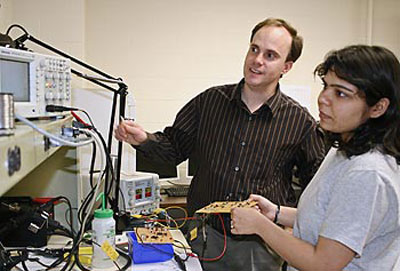| Nov 15, 2012 |
"Nanocanary", a modern-day, high-tech equivalent of the canary in a coal mine
|
|
(Nanowerk News) Nanotechnology is making a great impact on businesses by offering new and improved products, materials and processes for diverse applications such as electronics manufacturing, the aerospace, chemical and automotive industries, defense and homeland security, food and beverage packaging, health care, sporting goods, textiles and cosmetics.
|
|
But researchers are also assessing the health and environmental risks associated with this new technology due to exposure to, or contamination from, nanoparticles during production, storage and transportation.
|
 |
| Assoc. Prof. Joel Therrien works with a student in the lab.
|
|
To detect the toxicity of engineered nanomaterials, such as carbon nanotubes, on living cells, electrical engineering Assoc. Prof. Joel Therrien — along with biology Prof. Susan Braunhut, chemistry Prof. Kenneth Marx and work environment Asst. Prof. Dhimiter Bello — has developed a “nanocanary,” the modern-day, high-tech equivalent of the canary in a coal mine that warned miners of dangerous buildups of toxic gases in the mine shaft.
|
|
The nanocanary is an ultrasensitive biosensor designed to continuously monitor tiny physiological changes in the live cells contained within it.
|
|
In a recent podcast produced by the Museum of Science in Boston, Therrien talked about the importance of studying how nano-sized particles affect human health and the environment as well as in the safe development of commercial nano products.
|
|
“Our biosensor has a wide range of applications, from testing for toxicity in nanomanufacturing to drug development and customized cancer therapeutics,” notes Therrien.
|
|
“In testing the toxicity of carbon nanotubes, for example, since the sensor can directly detect adverse effects on living cells, we are able to identify the threshold concentration at which carbon nanotubes lead to the cells’ death,” he explains. “The sensor can also be used to test the response of normal and cancerous cells to drug therapies. In the future, this technology may help guide oncologists in selecting the most appropriate drug for a cancer patient. We also see the potential for this to partially replace animals in testing drugs and other products.”
|
|
You can listen to Therrien’s 16-minute interview, titled “Nanocanary: Sensing Small Things with Small Things”, by going to the museum’s website.
|

